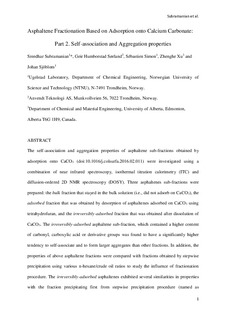| dc.contributor.author | Subramanian, Sreedhar | |
| dc.contributor.author | Sørland, Geir Humborstad | |
| dc.contributor.author | Simon, Sebastien Charles Roger | |
| dc.contributor.author | Xu, Zhenghe | |
| dc.contributor.author | Sjöblom, Johan | |
| dc.date.accessioned | 2018-02-09T12:19:23Z | |
| dc.date.available | 2018-02-09T12:19:23Z | |
| dc.date.created | 2016-11-18T10:05:18Z | |
| dc.date.issued | 2017 | |
| dc.identifier.citation | Colloids and Surfaces A: Physicochemical and Engineering Aspects. 2017, 514, 79-90. | nb_NO |
| dc.identifier.issn | 0927-7757 | |
| dc.identifier.uri | http://hdl.handle.net/11250/2483722 | |
| dc.description.abstract | The self-association and aggregation properties of asphaltene sub-fractions obtained by adsorption onto CaCO3 (doi:http://dx.doi.org/10.1016/j.colsurfa.2016.02.011) were investigated using a combination of near infrared spectroscopy, isothermal titration calorimetry (ITC) and diffusion-ordered 2D NMR spectroscopy (DOSY). Three asphaltenes sub-fractions were prepared: the bulk fraction that stayed in the bulk solution (i.e., did not adsorb on CaCO3), the adsorbed fraction that was obtained by desorption of asphaltenes adsorbed on CaCO3 using tetrahydrofuran, and the irreversibly-adsorbed fraction that was obtained after dissolution of CaCO3. The irreversibly-adsorbed asphaltene sub-fraction, which contained a higher content of carbonyl, carboxylic acid or derivative groups was found to have a significantly higher tendency to self-associate and to form larger aggregates than other fractions. In addition, the properties of above asphaltene fractions were compared with fractions obtained by stepwise precipitation using various n-hexane/crude oil ratios to study the influence of fractionation procedure. The irreversibly-adsorbed asphaltenes exhibited several similarities in properties with the fraction precipitating first from stepwise precipitation procedure (named as asphaltene 3.5V) including lower flocculation onset, higher tendency to self-associate (based on ITC) and a greater ability to adsorb onto stainless steel (based in QCM-D measurements). However, the size of aggregates determined by NMR differed, with the irreversibly-adsorbed asphaltenes forming aggregates of larger aggregate size (11.3 Å) than compared to asphaltene 3.5 V fractions (7.2 Å). In conclusion, our investigations indicate that the asphaltene precipitation tendency depends on both the aromaticity and polarity of asphaltene fractions, and some of the asphaltene sub-fractions present different properties than the whole (or unfractionated) asphaltene fraction. | nb_NO |
| dc.language.iso | eng | nb_NO |
| dc.publisher | Elsevier | nb_NO |
| dc.relation.uri | https://www.sciencedirect.com/science/article/pii/S0927775716309876 | |
| dc.rights | Attribution-NonCommercial-NoDerivatives 4.0 Internasjonal | * |
| dc.rights.uri | http://creativecommons.org/licenses/by-nc-nd/4.0/deed.no | * |
| dc.title | Asphaltene fractionation based on adsorption onto calcium carbonate: Part 2. Self-association and aggregation properties | nb_NO |
| dc.type | Journal article | nb_NO |
| dc.type | Peer reviewed | nb_NO |
| dc.description.version | acceptedVersion | nb_NO |
| dc.source.pagenumber | 79-90 | nb_NO |
| dc.source.volume | 514 | nb_NO |
| dc.source.journal | Colloids and Surfaces A: Physicochemical and Engineering Aspects | nb_NO |
| dc.identifier.doi | 10.1016/j.colsurfa.2016.11.035 | |
| dc.identifier.cristin | 1401649 | |
| dc.relation.project | Norges forskningsråd: 234112 | nb_NO |
| dc.description.localcode | © 2016 Elsevier B.V. All rights reserved. This is the authors' accepted and reviewed manuscript of the article, locked until 14 November 2018 due to copyright restrictions. | nb_NO |
| cristin.unitcode | 194,66,30,0 | |
| cristin.unitname | Institutt for kjemisk prosessteknologi | |
| cristin.ispublished | true | |
| cristin.fulltext | original | |
| cristin.fulltext | postprint | |
| cristin.qualitycode | 1 | |

